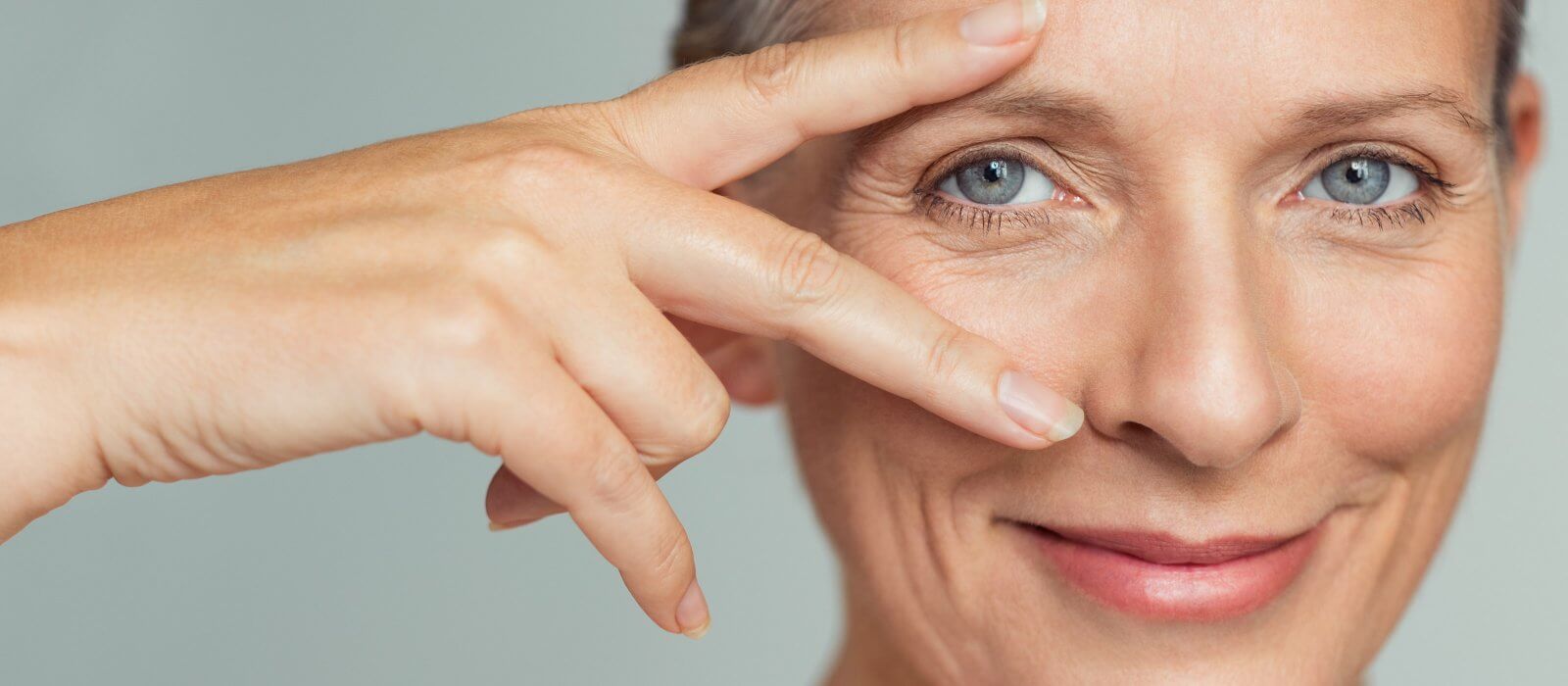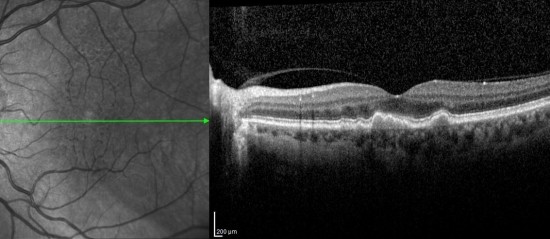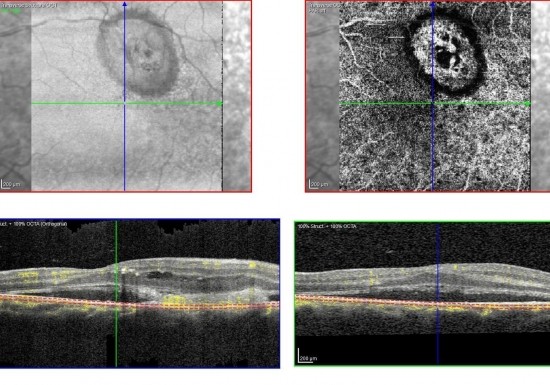
Age-related macular degeneration AMD
We are experts for age-related macular degeneration
Ophthalmologist for age-related macular degeneration – AMD
Age-related macular degeneration (AMD) is the leading cause of considerable vision impairment up to blindness in Germany and the rest of the Western world. With AMD, the retina is attacked at the macula, in the back of the eye. Learn everything about AMD and how we can help you!
We are an ophthalmic practice specialised on AMD
- Our ophthalmic practice at the heart of Düsseldorf has specialised on the detection and treatment of age-related macular degeneration (AMD).
- Our experienced team of doctors conduct special AMD prevention examinations, explain the diagnosis comprehensively, and immediately start the appropriate therapy.
- In case of a wet AMD, we provide exhausting counseling and perform intravitreal injection therapy.
You are very welcome to make an appointment for extensive consultation and examination at our practice.
Age-related macular degeneration: Important questions and answers
-
What is the macula?
The so-called „Yellow spot“ (macula in medical terms) is located on the back of the retina. Due to extreme high density of colour-sensitive nerve cells, the macula is responsible for sharp and coloured vision. With our photoreceptor cells at the macula, we focus objects and see sharply. The peripheral retina is for visual orientation.
-
How do I perceive age-related macular degeneration?
The first signs of age-related macular degeneration (AMD) are disorders at the central field of vision, such as blurred vision. The degree of disturbance may vary according to the stage of the disease. Starting from blurred silhouettes and weak contrast, it can lead to a grey spot at the central field of vision. The typical symptom is a blurred vision (so-called metamorphopsies) at which straight lines are perceived warped.
-
Who is likely to be affected from AMD?
The risk to suffer from age-related macular degeneration (AMD) increases with age. A genetic predisposition is the main cause for a development of an macular degeneration. We recommend an annual preventive examination after your 55th birthday. We would like to conduct this annual preventive examination for you – for early detection, for monitoring a known macular degeneration, or for other retinal diseases.
The different types of age-related macular degeneration
Age-related macular degeneration (AMD) can be divided into:
- dry macular degeneration
- and, less common, wet macular degeneration
At our ophthalmic practice in Düsseldorf, thanks to top-notch technology, we are able to detect eye diseases such as the macular degeneration at an early stage and treat them appropriately.
Optical coherence tomography (OCT) is our most important tool of examination. When a wet AMD is suspected, an accurate diagnosis can be achieved through OCT angiography and fluorescene angiography.
Dry age-related macular degeneration
The dry AMD
- A dry AMD develops slowly and painlessly.
- Over the years, vision and reading ability are continuosly reduced through the breakdown of photoreceptor cells.
- At an early stage, so-called plaque, waste products of the metabolism, is found below the retina.
- With increasing age and the care of time, the plaque gets more and may affect the macular function.

Progression of dry AMD
Progressed dry AMD is defined by so-called geographic atrophy. This means that photoreceptor cells die and a scar forms in the macula tissue. Then, patients have massive visual impairment. To this date, unfortunately, there is no reliable therapy for the treatment of dry AMD. If an AMD is diagnosed early, the avoidance of known risk factors can have a positive effect on the course of the disease.
A dry AMD can develop into a wet AMD. That is why preventive screenings are so important here.
Wet age-related macular degeneration
Wet AMD
- The far less often and more aggressive wet AMD has new blood vessels growing into the retina. This leads to the storage of liquids at the central retina. Sometimes, leaky vessels may lose blood.
- At an advanced stage, scars will form in the central retinal area.
- If not treated, this disease can lead to blindness.

Slowing down wet AMD through therapy
Today, wet AMD is effectively treatable if diagnosed early. The course of the disease can be slowed down significantly or even be stopped at times.
The main means of therapy are intravitreal injections (application of medicaments into the eye). This is an uncomplicated and painless intervention at which pharmaceuticals are injected into the eye. Medicaments available today are Ranibizumab (Lucentis), Aflibercept (Eylea), and Bevacizumab (Avastin).
Risk factors of AMD
What are the risk factors for age-related macular degeneration?
There are a couple of circumstances that promote a development of AMD.
Among these:
-
Smoking
Smoking is also bad for the eye and the macula. Try to become or stay smoke-free.
-
Blood pressure and blood lipids
Take care of your health and strive for a healthy blood pressure. Good blood lipid values are key, too, for maintaining your eyes in good shape.
-
UV light
Too much sunlight is bad for the eyes – protect your eyes from strong sunlight by wearing sunglasses with appropriate UV protection.
-
Genetics
If known cases of AMD run in your family, please see to come to a regular preventive eye screening, especially at high age.
-
Gender
Women happen to develop more often age-related macular degeneration.
Therapies for AMD patients
How can age-related macular degeneration be treated?
At first, we have to identify the type of age-related macular degeneration that our patient is dealing with.
- Today, wet AMD is well treatable. A trigger of age-related macular degeneration is the transmitter VEGF (= Vascular Endothelial Growth Factor). It causes pathological vessel growth.
- For the treatment of age-related macular degeneration, a VEGF inhibitor is used in order to fight this transmitter and reduce or stop new vessel growth.
AMD therapy with VEGF inhibitors
The therapy uses a state-of-the-art VEGF inhibitor, giving the chance to stop the patient’s vision loss. In many cases, a vision improvement can be achieved.
The stage of the AMD-induced changes is crucial for the therapy to succeed. The earlier a diagnose is made, the better the therapy of age-related macular degeneration – generally speaking.
Use of VEGF inhibitors through eye injection
- The injection of a medicament is a routine intervention, carried out for outpatients at our operating room.
- The VEGF inhibitor is directly applied as a medicament to the eye, where it can be most effective.
- The patient’s eye is sedated under anaesthetics and immobilised.
- Then, the puncture is performed with a super-fine cannula right into the vitreous body of the eye.
Don’t be afraid of injection therapy!
It may sound scary at first, but don’t let it upset you: We work very sensitively, absolutely sterile and most precisely, so you will experience this quick, minimally invasive procedure without any pain.
We are happy to give you all information, and we take a lot of time to discuss the therapy in detail. Please feel free to get in touch.



